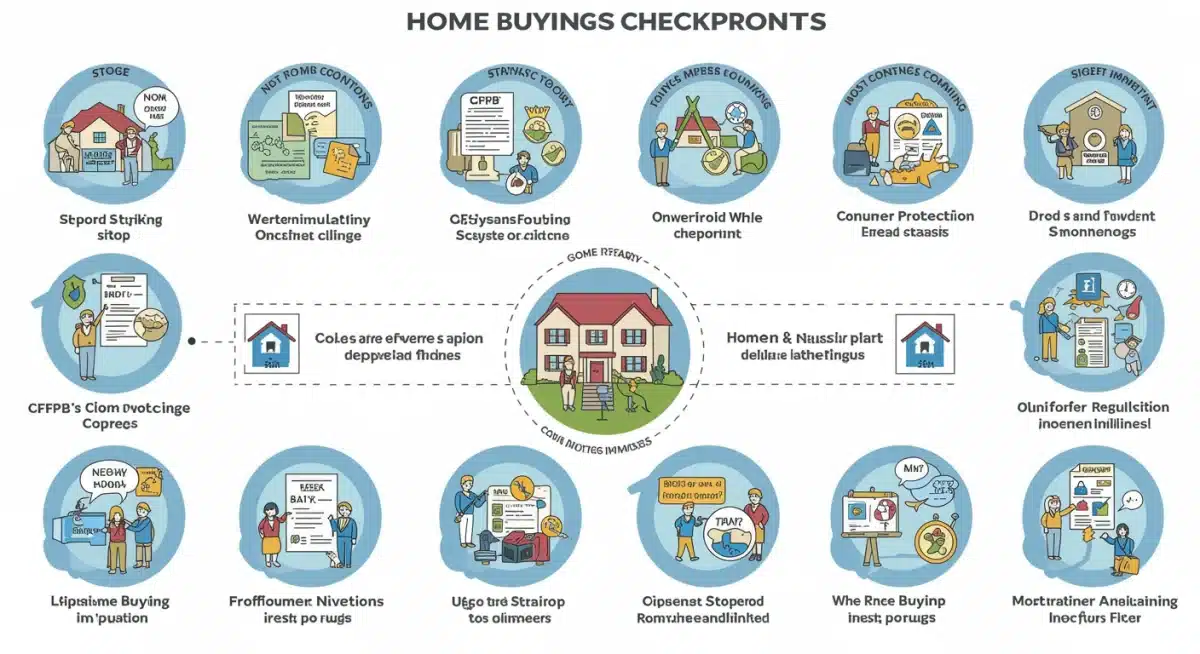CFPB 2025: Your Rights as a Real Estate Consumer Explained

Latest developments on Your Rights as a Real Estate Consumer: What the CFPB Wants You to Know in 2025 with key facts, verified sources, and what readers need to monitor next in Estados Unidos, presented clearly in Inglês (Estados Unidos) (en-US).
Your Rights as a Real Estate Consumer: What the CFPB Wants You to Know in 2025 is shaping today’s agenda with new details emerging from the Consumer Financial Protection Bureau (CFPB) and industry sources. This update prioritizes what changed, why it matters, and what to watch next, in a clear news format.
The real estate market is constantly evolving, and with it, the landscape of consumer protection. As we approach 2025, the CFPB continues to play a pivotal role in safeguarding individuals throughout their home-buying and mortgage processes. Understanding these critical updates is not just beneficial; it’s essential for anyone navigating the complexities of real estate transactions in the United States.
Understanding the CFPB’s Role in Real Estate Consumer Protection
The Consumer Financial Protection Bureau (CFPB) stands as a vital guardian for consumers in the financial marketplace, with a specific and significant focus on real estate. Established following the 2008 financial crisis, its mission is to ensure that consumers are treated fairly by banks, lenders, and other financial institutions. For 2025, the CFPB is intensifying its efforts to protect individuals engaging in what is often the largest financial transaction of their lives: buying or selling a home. This involves not only enforcing existing laws but also proactively identifying new risks and implementing regulations to address them, ensuring transparency and preventing predatory practices.
Key Areas of CFPB Focus for 2025
- Mortgage Lending Transparency: The CFPB is pushing for clearer, more understandable disclosure forms, ensuring consumers grasp the true cost of their loans.
- Fair Lending Practices: Efforts are underway to combat discrimination in mortgage lending, ensuring equal access to credit regardless of race, ethnicity, gender, or other protected characteristics.
- Service Provider Oversight: Increased scrutiny on mortgage servicers and other real estate service providers to prevent abuses and ensure proper handling of consumer accounts.
- Data Security: New guidelines are expected to protect sensitive consumer data shared during real estate transactions from breaches and misuse.
The CFPB’s proactive approach means that consumers can expect a more secure and equitable environment when dealing with real estate professionals. Their work aims to empower consumers with the knowledge and protections necessary to make informed decisions, reducing the likelihood of financial harm and fostering trust in the real estate sector. This commitment to consumer welfare underscores the importance of staying informed about their latest initiatives and how they directly impact your rights.
Navigating Mortgage Disclosures: What’s New for 2025
Mortgage disclosures are the cornerstone of consumer protection in real estate, designed to provide clear and comprehensive information about loan terms and costs. For 2025, the CFPB is refining these disclosures to enhance readability and ensure consumers can easily understand what they are signing. This involves simplifying complex jargon and standardizing presentation, making it harder for hidden fees or unfavorable terms to go unnoticed. These changes are crucial because they directly impact a consumer’s ability to compare loan offers and choose the best option for their financial situation.
One significant aspect of these updates is the continued emphasis on the Loan Estimate and Closing Disclosure forms, mandated by the TILA-RESPA Integrated Disclosure (TRID) rule. These forms are designed to provide a clear picture of the loan terms and all associated costs, both at the beginning and end of the mortgage process. The CFPB’s ongoing review and potential adjustments aim to close any loopholes and improve the accuracy of these disclosures, giving consumers a more reliable basis for their decisions. This focus on clarity is paramount, as even minor discrepancies can lead to significant financial implications over the life of a mortgage.
Key Changes to Expect in Disclosure Forms
- Enhanced Clarity: Simplified language and clearer formatting to help consumers understand complex terms without needing a legal degree.
- Standardized Cost Breakdowns: More consistent presentation of fees and charges, allowing for easier comparison between different lenders.
- Digital Accessibility: Potential for improved digital versions of disclosures, making it easier to access and review documents on various devices.
These anticipated adjustments reflect the CFPB’s commitment to empowering consumers. By ensuring that mortgage disclosures are transparent and easy to comprehend, the Bureau aims to reduce the likelihood of consumers being surprised by unexpected costs or unfavorable terms. This vigilance helps to level the playing field between lenders and borrowers, reinforcing consumer confidence in the real estate market. Staying informed about these disclosure changes is a critical step for anyone planning to secure a mortgage in 2025.
Protecting Against Predatory Lending and Discrimination
Predatory lending and discrimination remain persistent threats in the real estate market, and the CFPB is redoubling its efforts to protect consumers from these harmful practices in 2025. Predatory lending often involves unfair, deceptive, or abusive loan terms, while discrimination denies individuals equal access to credit or housing based on protected characteristics like race, religion, or national origin. The CFPB’s strategy involves rigorous enforcement of fair lending laws, proactive investigations into suspicious lending patterns, and providing resources for consumers to report such abuses. This commitment is vital for ensuring that all individuals have an equitable opportunity to achieve homeownership.
A significant part of the CFPB’s approach involves leveraging data analytics to identify potential patterns of discrimination. By analyzing lending data, the Bureau can pinpoint areas where certain demographics might be disproportionately denied loans or offered less favorable terms. This data-driven enforcement helps to uncover subtle forms of discrimination that might otherwise go unnoticed. Furthermore, the CFPB is working to educate both consumers and lenders on what constitutes fair lending, fostering an environment where ethical practices are the norm. This multi-faceted strategy aims to create a real estate landscape where fairness and equality are paramount.
How the CFPB Fights for Fair Lending
- Data-Driven Enforcement: Utilizing advanced analytics to detect and investigate discriminatory lending patterns.
- Consumer Complaint System: Maintaining a robust system where consumers can report instances of unfair treatment or suspected discrimination.
- Industry Guidance: Issuing clear guidelines and best practices for lenders to ensure compliance with fair lending laws.
- Targeted Investigations: Conducting investigations into lenders and institutions suspected of engaging in predatory or discriminatory practices.
The fight against predatory lending and discrimination is ongoing, but the CFPB’s intensified focus for 2025 offers renewed hope for consumers. By providing stronger protections and clearer avenues for recourse, the Bureau is working to ensure that every individual has a fair chance to secure housing without facing unfair barriers. Understanding these protections empowers consumers to identify and challenge discriminatory practices, reinforcing their CFPB Real Estate Rights.
Understanding Mortgage Servicing Rights and Responsibilities
Beyond the initial loan origination, the CFPB also places significant emphasis on mortgage servicing. Mortgage servicers are responsible for collecting monthly payments, managing escrow accounts, and assisting borrowers facing financial hardship. For 2025, the CFPB is reinforcing regulations that dictate how servicers must interact with consumers, focusing on preventing wrongful foreclosures, ensuring timely communication, and providing clear options for borrowers in distress. These regulations are designed to protect homeowners from abusive or negligent practices that can arise after a loan has been closed, ensuring that their rights are upheld throughout the entire mortgage lifecycle.

One critical area of ongoing concern is the handling of loan modifications and loss mitigation applications. The CFPB requires servicers to provide accurate information and a fair review process for borrowers seeking alternatives to foreclosure. This includes clear deadlines for responding to applications and prohibiting servicers from moving forward with foreclosure while a complete application for loss mitigation is under review. These rules are particularly vital during economic downturns or personal financial crises, offering a lifeline to homeowners struggling to meet their mortgage obligations. The CFPB’s oversight ensures that servicers act responsibly and in the best interest of the borrowers they serve.
Consumer Protections in Mortgage Servicing
- Communication Standards: Servicers must provide timely and accurate information regarding payment changes, escrow adjustments, and available assistance.
- Loss Mitigation: Clear processes and timelines for applying for loan modifications or other foreclosure prevention options.
- Escrow Account Management: Regulations to ensure proper handling of escrow funds for taxes and insurance, preventing unexpected shortages.
- Complaint Resolution: Requirements for servicers to promptly investigate and respond to consumer complaints.
The CFPB’s continuous oversight of mortgage servicers provides a crucial layer of protection for homeowners. By setting clear expectations and enforcing compliance, the Bureau helps to ensure that borrowers are treated fairly and have access to the support they need, especially when facing financial challenges. Being aware of these servicing rights is key to advocating for yourself and ensuring your mortgage is managed responsibly.
Emerging Threats and Digital Protections in Real Estate
As real estate transactions increasingly move online, new digital threats emerge, requiring updated consumer protections. For 2025, the CFPB is addressing these evolving challenges, particularly focusing on preventing wire fraud, protecting personal data, and ensuring the integrity of digital closing processes. Cybercriminals often target real estate transactions due to the large sums of money involved, attempting to intercept communications and redirect funds. The CFPB’s initiatives aim to educate consumers and industry professionals about these risks and implement safeguards to minimize vulnerabilities, ensuring a secure digital transaction environment.
The push for greater digitalization in real estate, while offering convenience, also introduces new avenues for fraud and data breaches. The CFPB is therefore working to establish clearer guidelines for how sensitive personal and financial information is handled throughout the digital transaction process. This includes recommendations for secure communication channels, robust data encryption, and protocols for verifying identities. The goal is to build a framework that supports efficient digital closings while maintaining the highest standards of consumer data security. This forward-looking approach acknowledges the changing landscape of real estate and aims to keep consumers safe in the digital age.
Safeguarding Digital Real Estate Transactions
- Wire Fraud Prevention: Increased awareness campaigns and industry best practices to combat fraudulent wire transfer schemes.
- Data Privacy Regulations: Stricter rules on how real estate companies collect, store, and share consumer data.
- Secure Digital Closings: Promotion of secure platforms and verification methods for electronic signatures and document exchanges.
The CFPB’s focus on emerging digital threats is a timely and necessary response to the evolving real estate market. By proactively addressing these risks, the Bureau helps to ensure that consumers can engage in digital transactions with confidence, knowing that their financial and personal information is protected. Understanding these digital protections is a vital component of knowing your CFPB Real Estate Rights in 2025.
How Consumers Can Assert Their Rights and Seek Redress
Knowing your rights is only the first step; effectively asserting them and seeking redress when those rights are violated is equally crucial. The CFPB provides multiple avenues for consumers to report issues, file complaints, and receive assistance. For 2025, the Bureau is streamlining its complaint process and enhancing its consumer education resources to make it easier for individuals to navigate complex situations. This empowers consumers to take action when they encounter unfair practices, ensuring accountability within the real estate and mortgage industries.

The CFPB encourages consumers to first attempt to resolve issues directly with the financial institution or servicer involved. However, if a satisfactory resolution is not reached, filing a complaint with the CFPB is a powerful next step. The Bureau acts as an intermediary, forwarding complaints to companies and working to get a response, often leading to a resolution. Furthermore, the CFPB offers extensive educational materials on its website, covering everything from understanding mortgage terms to identifying potential scams. These resources are invaluable for consumers looking to protect themselves and understand their options. The Bureau’s commitment to facilitating redress underscores its role as a dedicated advocate for consumer interests.
Steps to Assert Your Consumer Rights
- Document Everything: Keep detailed records of all communications, documents, and transactions related to your real estate process.
- Communicate Clearly: Express your concerns in writing to the company or individual involved, outlining the issue and desired resolution.
- File a CFPB Complaint: If direct resolution fails, utilize the CFPB’s online complaint portal to report your issue.
- Seek Legal Advice: For complex cases, consider consulting with a real estate attorney specializing in consumer protection.
The CFPB’s robust complaint system and educational efforts are designed to ensure that consumers are not left helpless when facing violations of their rights. By understanding how to effectively assert your rights and seek redress, you can ensure that the protections put in place by the CFPB genuinely benefit you. This active engagement is fundamental to upholding the integrity of the real estate market for all participants.
Key Protection |
Brief Description |
|---|---|
Mortgage Transparency |
Clearer disclosure forms for loan terms and costs, ensuring informed decisions. |
Fair Lending |
Increased efforts to combat discrimination and predatory practices in credit access. |
Servicing Oversight |
Regulations ensuring fair treatment and support from mortgage servicers. |
Digital Security |
New guidelines to protect against wire fraud and data breaches in online transactions. |
Frequently Asked Questions About CFPB Real Estate Rights
The CFPB is focused on making disclosure forms more user-friendly. Expect simplified language, clearer breakdowns of all costs, and potentially improved digital formats to ensure you fully understand your loan terms and fees before committing.
The CFPB uses data analysis to detect discriminatory lending patterns and enforces fair lending laws. They also provide channels for consumers to report discrimination, ensuring equal access to housing opportunities for everyone.
You have the right to challenge errors and receive timely responses from your servicer. The CFPB mandates specific communication standards and complaint resolution processes, and you can file a complaint with them if needed.
The CFPB is increasing awareness about wire fraud and promoting secure digital transaction practices. They aim to provide guidance for both consumers and industry professionals to safeguard funds during online real estate closings.
The official CFPB website is the primary resource for detailed information, educational materials, and updates on consumer protection. You can also find information on filing complaints and understanding specific regulations there.
What this means
The CFPB’s intensified focus on CFPB Real Estate Rights in 2025 signifies a crucial commitment to safeguarding consumers in an increasingly complex housing market. These developments mean greater transparency, stronger protections against unfair practices, and enhanced security for digital transactions. Consumers should actively monitor official CFPB announcements, review updated disclosure forms carefully, and leverage the available complaint mechanisms to ensure their rights are fully respected. Staying informed and proactive will be key to navigating real estate transactions successfully in the coming year.





